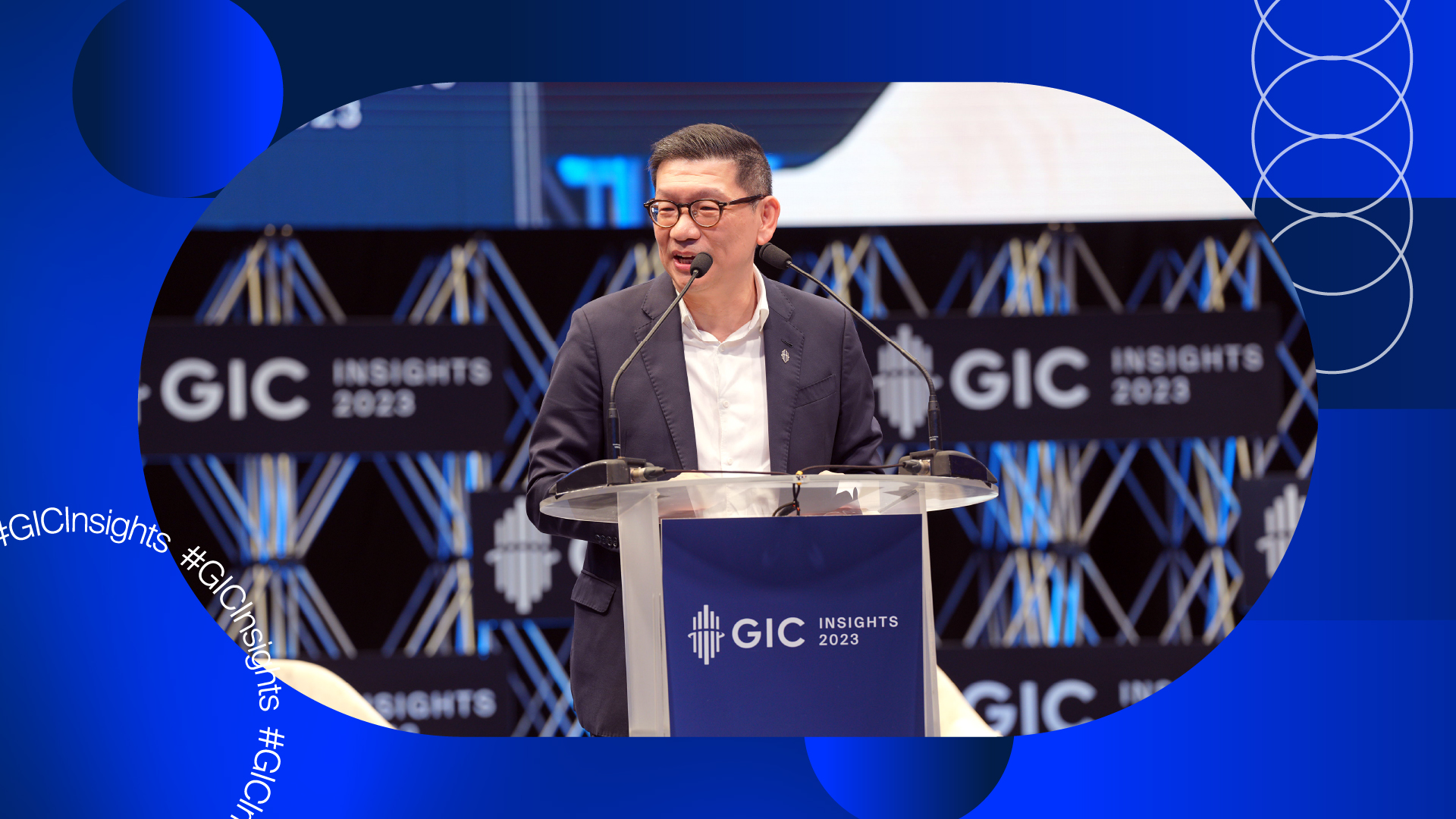This article was originally published on 13 November 2023 by The Straits Times, and is based on GIC CEO Lim Chow Kiat’s opening remarks at GIC Insights 2023 in Singapore.
Recent events, including the tragedy in the Middle East, were a stark reminder that we continue to live in uncertain times. From geopolitical tensions to macroeconomic headwinds and ever frequent climate disasters, we are grappling with crises on multiple fronts.
Despite these volatile times, or because of them, long-term investors must double down on hope and opportunity.
Hope is not a strategy, but without it, few solutions would be possible. Similarly, opportunity is nothing without ability. They motivate us to unlock new horizons. I will briefly touch on three of these new frontiers.
Restoration of asset yields
Volatility is where the first opportunity lies.
While the US economy has shown resilience, the prospect of interest rates moving higher for longer signals the end of 40 years of easy money in many developed economies. Higher costs of capital challenge both the real economy and financial markets. Emerging markets offer pockets of good growth, but in countries like China, deleveraging and the search for a new economic model are adding to global headwinds.
It is well-known that in investing, pricing matters a great deal. The eventual investment return depends on not just how the asset performs, but how the performance deviates from what has been discounted in the entry price. Fluctuations in asset prices can create opportunities.
The rapid rise in interest rates has dramatically shifted the pricing of many assets, especially in the case of bonds. In March this year, the resulting losses for bonds were a proximate cause of the crisis in US regional banks. These losses could be staggering.
One dramatic example of this is the 100-year bond issued by Austria in June 2020 at around par. As the yield of this bond rose by just 2% to 2.8%, its long duration resulted in a mark-to-market loss of over 60%.
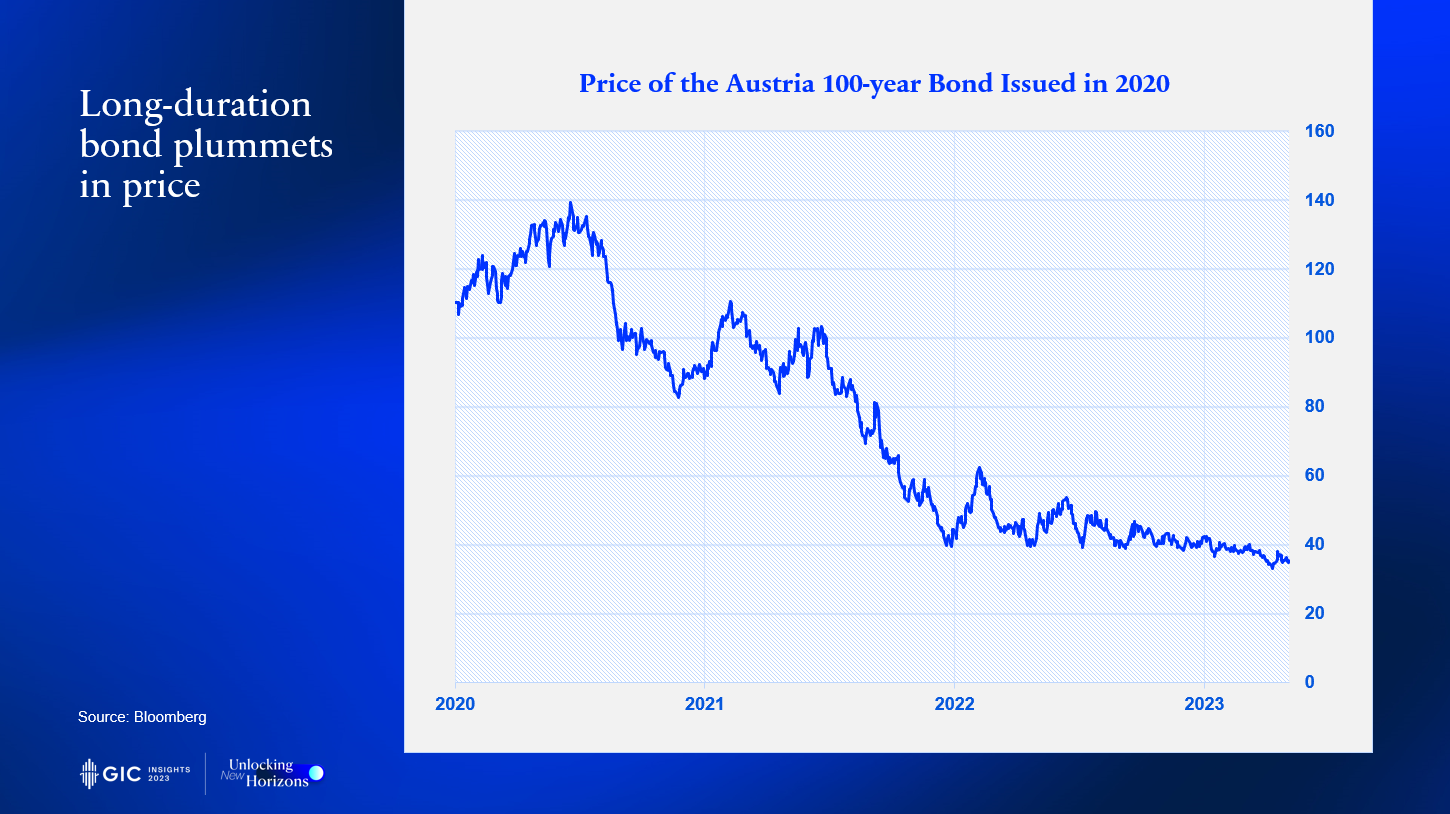
But the rise in interest rates has seeded future returns. Take the case of the US Treasury Inflation Protected Securities (TIPS), the inflation-indexed bonds issued by the US government. They have seen a similar, considerable jump in their real yield, inflicting losses initially. However, they now offer a potential risk-free real return of 2.7% per annum for the next 20 years.
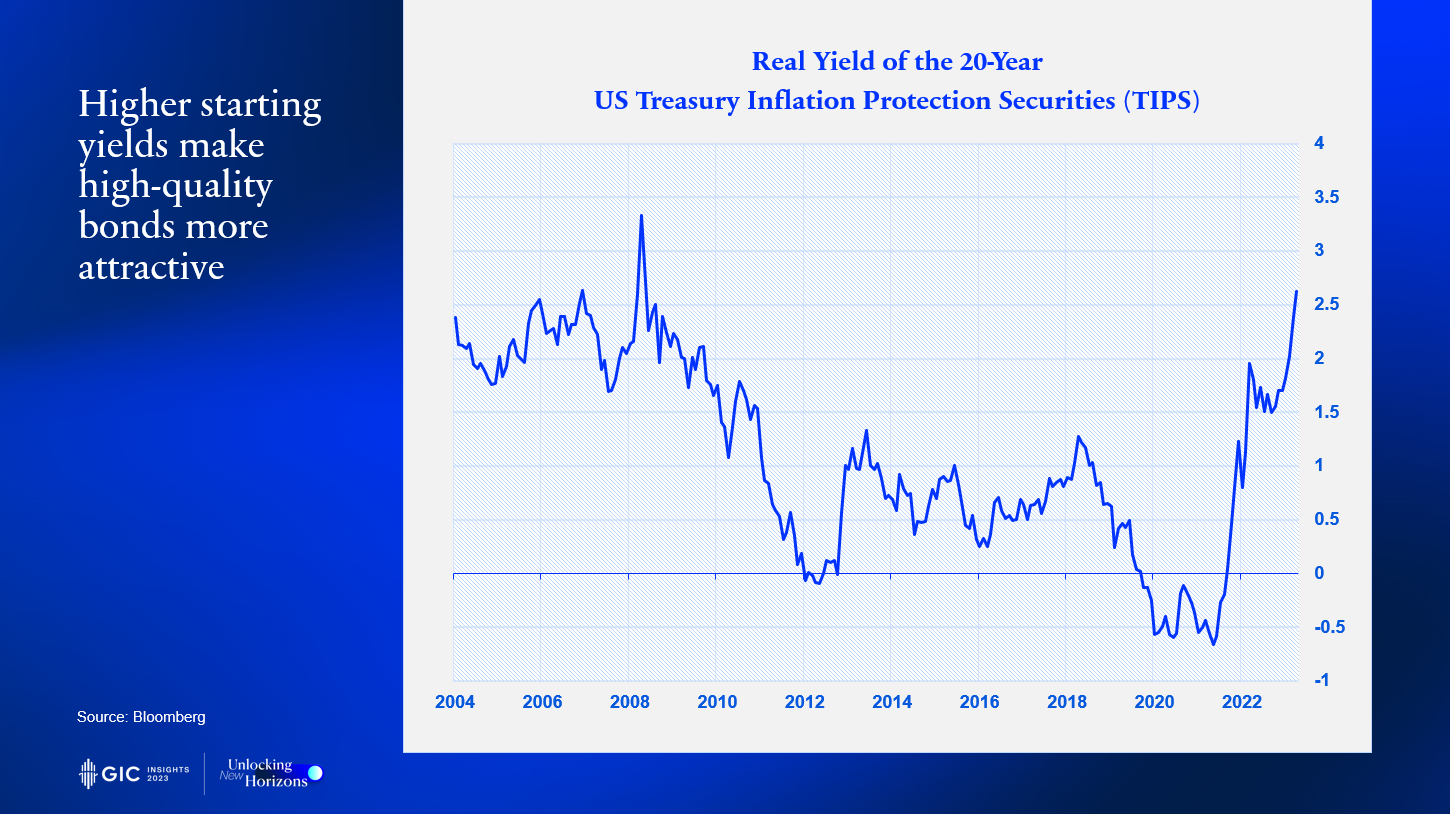
While entry yields are a good predictor of ex-post returns for high-quality government bonds with stable cash flows and low repayment risk, the prospects for other asset types are more uncertain. Nonetheless, higher asset yields, or better asset pricing, are generally favourable. Take credit as an example – it is now possible to find equity-like returns for assuming investment-grade credit risks.
Beyond fixed-income products, investors must observe how other assets adjust to a “higher-for-longer” environment. Higher refinancing costs, which affect businesses, households, and governments, require careful planning and adjustments.
The numerous business models built up during the prolonged period of low interest rates could be a cause for concern. Reliance on low financing costs may no longer be tenable. However, in the longer term, the return to a more appropriate cost of capital could reduce cases of capital misallocation.
Overall, while the move up in interest rates has been painful for investors with long positions in bonds, the restoration of asset yields is a much better starting point for investors, especially those who are long-term.
The great green transition
The next opportunity lies in problems, specifically climate problems.
A large quantum of investments must be mobilised to accelerate the low-carbon transition. Just in clean energy, US$4.3 trillion (S$5.83 trillion) is required per year by 2030, according to the International Energy Agency (IEA).
There remains a significant gap to meet that goal. The IEA has just published its latest World Energy Outlook: In 2023, annual clean energy investments are projected to amount to a record high of US$1.8 trillion, but this amount will still be less than half of what is needed.
The funding gap for emerging markets and developing economies is especially stark. Annual investments are estimated at almost US$0.8 trillion today, and this needs to triple by 2030.
Climate investments can be thought of broadly in two categories: Climate solutions refer to innovative decarbonisation technologies, and transition finance supports presently carbon-intensive businesses in their shift towards more sustainable practices. Companies in the latter make up over 80% of the investment universe, using the MSCI All Country World Index (ACWI), an index tracking nearly 3,000 stocks in almost 50 developed and emerging markets, as a proxy.
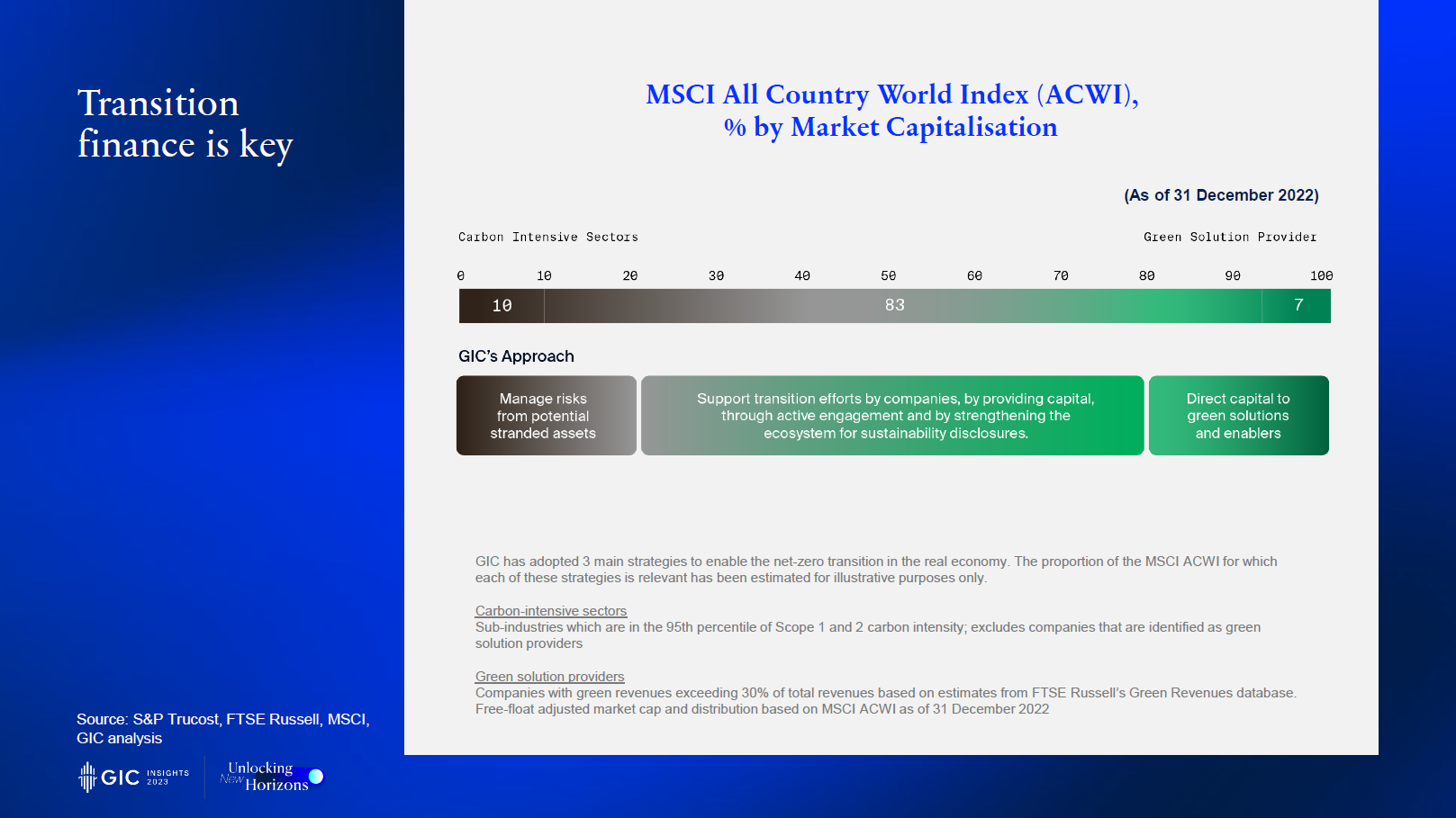
Where are the greatest climate revenue drivers? Based on GIC research, sustainable vehicles, electricity networks, solar, wind, and hydrogen are among the solutions with the greatest incremental revenue potential.
In transition finance, the work is usually more complicated. Here, investors are looking for businesses with credible plans to move to lower-carbon business models. As they do so, they become more resilient to climate risks, fetching better valuation. They may also find new revenue streams, further adding to their value.
But it is still challenging to find bankable deals. Commercial viability, data availability, the capital-intensive nature of the projects, market and regulatory risks, and trade-offs with other important goals are among the barriers to scaling transition finance.
"GIC is committed to financing both climate solutions and companies in their transition. A few years ago, we set up an experimental Sustainable Investment Fund (SIF) to explore such opportunities. The results were encouraging, so SIF has since evolved into three larger portfolios embedded in our asset departments, covering asset classes across public and private markets. Each portfolio has a dedicated team and significant capital to deploy."
— Lim Chow Kiat, CEO, GIC
A word about AI
Before moving on to the third opportunity, one cannot ignore the topic of artificial intelligence (AI).
AI is the buzzword of the year, including on company earnings calls. Mentions of the technology have more than tripled in the past 12 months.
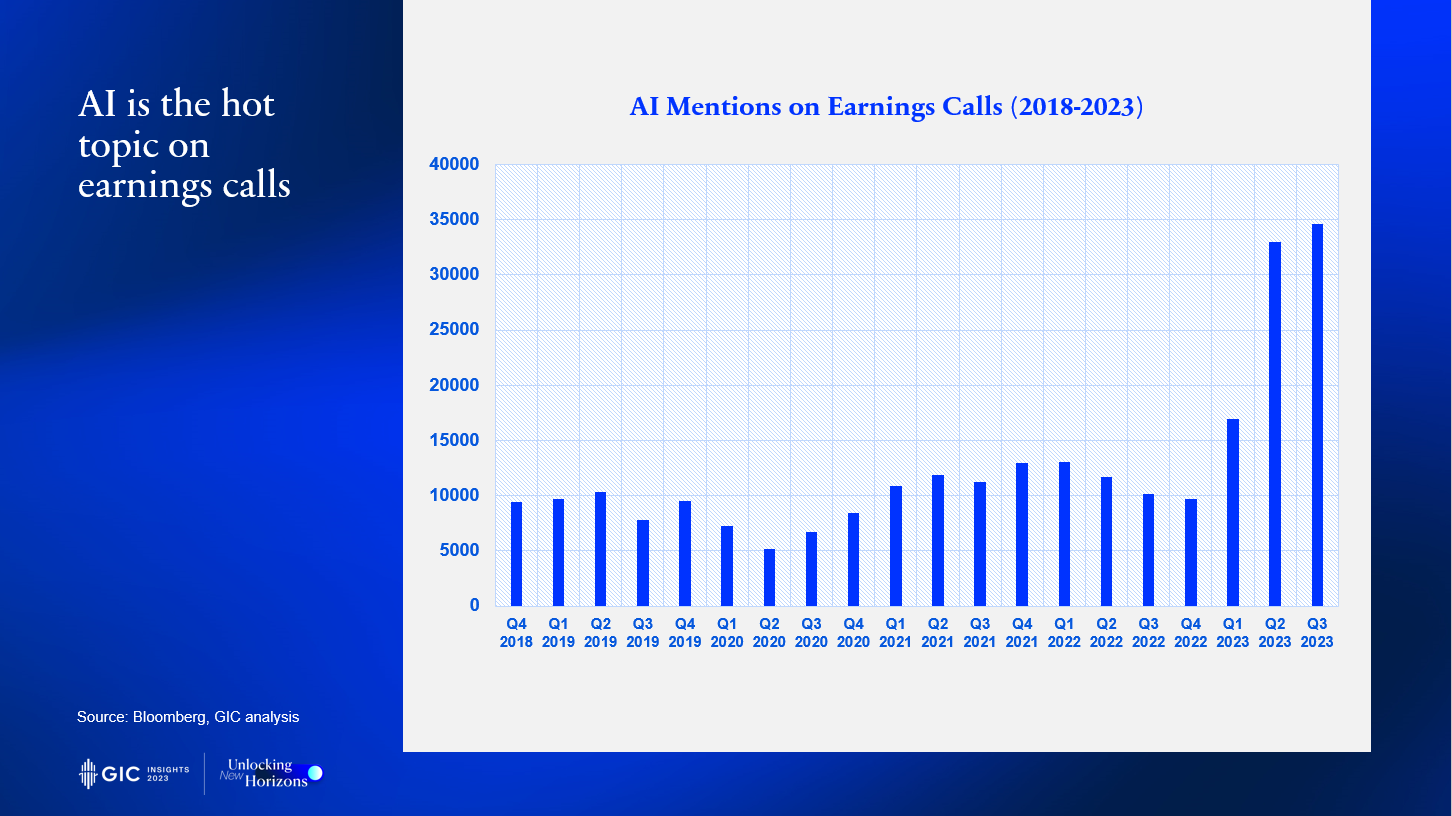
AI has long been in the works, but it has only really burst onto the scene with generative AI. It’s an “80-year overnight success”, as a speaker at GIC’s Bridge Forum said six months ago.
I consider the following three points when thinking about AI. First, it has the promise of transforming many, if not all, businesses. Yet it also raises many concerns around ethics, cybersecurity, job displacement and the environment, among others.
Second, AI is likely to go through a hype cycle, which means we should be mindful of short-term overestimation and then be even more careful about long-term inattention.
Third, investors must focus on value capture rather than just the advancement of the technology. It is one thing to be dazzled by the technology, but if the value is captured elsewhere, then it is likely not a good investment.
Partnership and fragmentation
The third opportunity lies in fragmentation, which is yet another buzzword.
I am not talking about profiting from supply chain reconfiguration, even though some countries and businesses clearly benefit and hence make good investments.
Instead, I am reaffirming the value of long-term partnerships, which are critical to capturing many of the high-potential opportunities that lie ahead.
Amidst growing uncertainty in the investment environment, some believe that we must outbid each other for every possible opportunity, leading to greater fragmentation. I disagree. Investing is not a zero-sum game, and there are ample opportunities for investors and businesses to co-create value and generate returns, even in highly fragmented markets. Indeed, considering the scale of investment needs, investors going it alone would not bring about the required capital and expertise.
In forging collaborations, GIC adopts a mindset of being fair, friendly, and firm to all our partners. It is an approach we take seriously, apply across all geographies and asset classes, and hope to pass down from generation to generation.
"Overall, despite the daily drumbeat of depressing news, hope and opportunities can still be found amid financial volatility, the climate crisis, technological disruption, and broader global fragmentation. Importantly, investors and business leaders, have a responsibility to unlock these opportunities for a more sustainable world."
— Lim Chow Kiat, CEO, GIC

